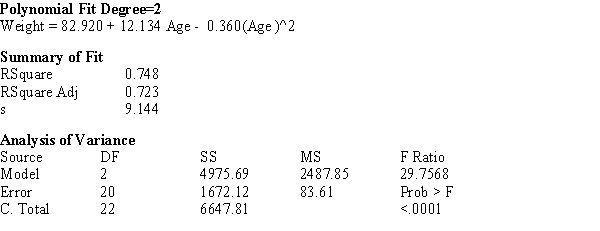Polar bear cubs are born in the winter in dens, and they must live off the fat stores of the mother even after leaving the den for sea ice, since the availability of their prey is unpredictable. Therefore, maternal weight is an important factor in successful reproduction of polar bears. In a recent spring, 261 adult females with 492 cubs were captured as they left their dens, and the mothers' weight and ages were determined by "counting annuli in the cementum of an extracted vestigial premolar tooth." (We are NOT making this up!) A quadratic fit of the maternal weight in kilograms to age in years resulted in the regression analysis below. 

a) On average, about how far off are the weights of the maternal bears? That is, what is a typical difference between the actual weights and the weights predicted by the quadratic model?
b) If the maternal weight is an important factor as discussed above, what age of the female would seem to be the best for reproduction success? In a few sentences, justify your answer by appealing to the information provided above.
Correct Answer:
Verified
b) T...
View Answer
Unlock this answer now
Get Access to more Verified Answers free of charge
Q17: The higher the value of the coefficient
Q18: If a scatter plot exhibits a strong
Q19: The value of Pearson's r is always
Q20: The slope of the least squares line
Q21: If a correlation coefficient r is close
Q23: The Des Moines Register recently reported the
Q24: A cause-and-effect relationship between two variables is
Q25: A common statistical method for estimating a
Q26: An ice cream seller wants to predict
Q27: The data below were gathered on a
Unlock this Answer For Free Now!
View this answer and more for free by performing one of the following actions

Scan the QR code to install the App and get 2 free unlocks

Unlock quizzes for free by uploading documents